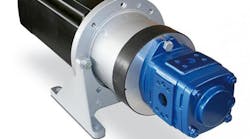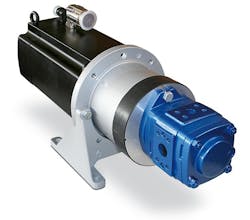Voithâs hydraulic servopump can be retrofit into existing machines that formerly used hydraulic servovalves. The result would be up to 70% lower energy consumption and noise reduction as much as 20 dBA.
The latest major player in the hydraulic servodrive market is Voith Turbo H + L Hydraulic GmbH, Rutesheim, Germany. Introduced at the 2015 Hannover Fair, Voith’s servopump adjusts to the power actually needed over varying volume flows and motor speeds. This provides clear advantages over conventional systems, particularly in the part load range, with a uniformly high volume flow that is needed only rarely within an operating cycle. Optimized operation reduces energy consumption by up to 70% and the total cost of ownership (TCO) of the entire hydraulic system by up to 35%. Voith officials say the cost of the servopump is usually amortized within one to two years.
The servopump system consists of three main components: a servo inverter, a synchronous servomotor, and a Voith internal gear pump. The servo inverter analyzes and processes the set point and the actual values of pressure and speed. It controls the highly responsive servomotor, which supplies the required torque to match load pressure. This power is transmitted to the hydraulic system as a function of the pressure or flow through the gear pump. As a result, classic valves are unnecessary, reducing the complexity of the system and the cooling capacity needed. At the same time, the reliability and lifetime increase.
Keys to the performance of the hydraulic servodrive are the low mass moment of inertia of the servomotor and the internal gear pump. This shortens the cycle time of the actuators as much as 50% to increase throughput of the machine. In addition to lower energy consumption, the Voith servopump reduces the noise emissions of the system by up to 20 dBA. The result is lower cost and effort for noise abatement measures. Voith officials say that in many cases, workplace guidelines are met without any additional measures.
The Voith servopump is offered as a turnkey solution. Pressure and flow are individually adjusted to the specific cycle data and synchronized with existing control concepts and systems. The system, therefore, lends itself as a retrofit to existing machines. Typical applications for the servopump include plastics and die-casting machines, machine tools, and presses. Because it is the central component of machines and systems, it continuously measures operating parameters, making it well suited as node for integration within Industry 4.0.
For more information, contact Voith Turbo H + L Hydraulic GmbH, Rutesheim, Germany, via its website at www.voith.com.



